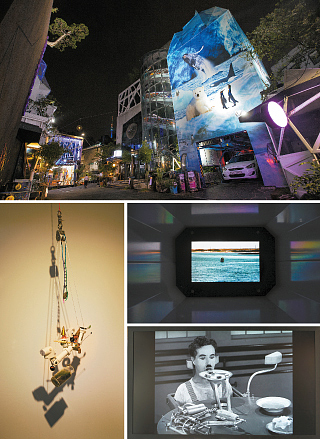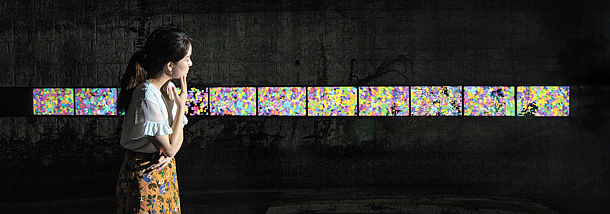[ZOOM KOREA] Once-thriving arts hub gets its groove back

Park Dong-hoon, the CEO of Hands BTL Media Group, stands in front of a street museum display featuring the work of Chinese media art artist Ji Zhou. [PARK SANG-MOON]
These little art museums are called micro museums, and are clustered near Yesultong. Additionally, street exhibits are located in the corners of the roads that make up the neighborhood. Walking down the road, one comes across a large gallery known as the Street Museum. These one-of-a-kind museums are the work of Park Dong-hoon of Hands BTL Media Group.

Clockwise from top: A night view of Yesultong, featuring a large-scale piece by artist Han Sungpil. A video piece from Peter Campus, a pioneer of media art, exhibited inside a micro museum. Charlie Chaplin’s “Modern Times” is screened inside of a outdoor space in Yesultong. A work from Kathleen J. Graves on display in one of the neighborhood’s street galleries. [PARK SANG-MOON]
Park was born in Sancheong in South Gyeongsang, and was raised by his grandmother. After he graduated from middle school, he came to Seoul. After settling in a little village in Hongje-dong, in western Seoul, he went out to the streets to earn money. Back then, there were many jobs available near the Eulji-ro and Chungmu-ro districts in the center of the city. He picked up whatever job he could get - from sorting through discarded paper and delivering food, to wrapping boxes and removing stickers.
Even when he was in high school, he had to work. He would pull snack carts and make toast for customers on the street, while also working as a ticket scalper outside of theaters.
He lived very competitively, and after working in a printing shop, an animation firm and a PR company, his life became increasingly more stable. Thanks to his diligence, he founded his own PR company in 1992 and his financial situation improved. After finding success with his company, he wanted to give back to society.
He made a visit to the Pil-dong community center because he felt indebted to the community which had helped him become financially stable. In the past, the area near Chungmu-ro was where culture and arts were centered and flourished, but those days have faded. The once-thriving publishing businesses relocated to Paju, Gyeonggi; the energetic movie industry relocated to Busan; and the fast-paced PR studios moved south of the Han River to Gangnam.
To reclaim the vitality that the Chungmu-ro area once had, he went out to the streets. He thought the first thing he could do was something related to the arts, and he started to look for foreign cases to study. After touring Naosima of Japan, the Tate Modern of England, and Aspen in the United States, he soon became an expert in the cultural regeneration business.

The work of Lee Lee-nam, a media artist, is set up alongside a wall. [PARK SANG-MOON]
The Yesultong Culture & Arts Space he created offers an area where people can freely enjoy exhibitions, concerts, movies, lectures, gardening, academics and food. Yesultong also acts as a playground for the neighborhood’s residents and local artists: Neighbors are often seen interacting with the artists who frequently visit the neighborhood. As of now, there are 13 micro museums displaying work throughout the neighborhood, and at the larger gallery space, works from both domestic and international artists are on display.
In addition to fine art-focused spaces, there is a small theater, a lecture and seminar room, and also a space called “Cooking Studio 24” which is used for cooking programs. The neighborhood is also home to gallery cafes and a pub.
Park is currently working on a program called the “Pil-dong School,” which he envisions will promote greater communication within the community and teach students ways to live a more sustainable life.
Park’s dream has never been fancy or grand. He said that he sometimes stops by places that many people visit, such as Seochon in central Seoul and Garosu-gil in southern Seoul. Each time he goes, one thing that he realizes is that neither is a distinct hub of culture like Yesultong. Park’s wish is that the art of Yesultong could become accessible for the whole country.
BY PARK SANG-MOON [moonpark@joongang.co.kr]










with the Korea JoongAng Daily
To write comments, please log in to one of the accounts.
Standards Board Policy (0/250자)